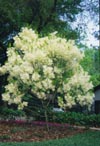Home >
Chionanthus virginicus, Fringetree
Fringetree looks best in a sunny spot sheltered from wind. The foliage appears more attractive when grown with several hours of shade but the tree blooms best in full sun. The tree probably does best overall with some afternoon shade. Trees cast light shade under the canopy making it easier to grow turf under the tree than under other trees with a denser canopy. It makes a great garden accent or patio tree and is suited for planting in buffer strips around parking lots.
Trees occur throughout the north and central portions of Florida south to Hardee County. Native habitat is eastern US to south-central Florida as an understory tree in upland woods to mountain tops 4000 feet in elevation and occasionally along stream banks (not in the water) throughout most of the eastern US from New Jersey to Florida. C. pygmaeus is endangered in Florida.
Like many trees, it prefers moist, acid soil. Some trees can be found in areas along streams that flood periodically. It grows very slowly, usually 6 to 10 inches per year, but can grow a foot per year if given rich, moist soil and plenty of fertilizer. Trees often grow as shrubs in the northern part of the hardiness range. Pollen from males cause significant allergy; females fruit but do not produce pollen.
There is only one flush of growth each year. Although reportedly difficult to transplant, Fringetree can be successfully moved quite easily with proper care. Flowers emerge from dormant buds before leaves. Trees transplanted in the fall in hardiness zone 6 do not grow roots until the following summer so be sure to keep new plants irrigated regularly. Plants grow slowly in the nursery, so expect to pay more for this tree than others of comparable size. Young tree canopies are typically un-balanced and not symmetrical.
Co-national champions are 41 x 31 and 32 x 35 feet in Virginia.






